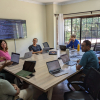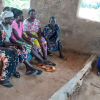What to do when the ink dries?
Last week, on 21 September we marked the International Day of Peace. On a day like that, still full with conflict and violence, it’s worth asking what we should do when the ink on a peace agreement has dried. Is peacemaking only the domain of a few elite diplomatic personalities and is all well after they put pen to paper?
Take the Egyptian-Israeli Peace Treaty as an example. Signed in 1979, it is the longest-standing peace agreement in the Middle East, lasting now for almost four decades. In his memoirs, Jimmy Carter, who brought together Anwar Sadat and Menachem Begin, the leaders of Egypt and Israel, , recalls showing Begin photographs of his grandchildren. Carter had signed each photograph with the children’s names, but insinuated to Begin that these mementoes would mean little if they couldn’t reach a peace agreement: “we talked quietly for a few minutes about grandchildren and about war”. As the popular success story goes, the tactic worked, and Begin agreed to sign the Camp David Accords.
Skillful diplomacy and unshakeable commitment also seem to be instrumental in other modern groundbreaking peace agreements. Consider the work of Richard Holbrooke, President Clinton’s special envoy for Bosnia, in diplomatic negotiations between the leaders of Bosnia, Croatia and Serbia in the 1990s. Or the 37 visits to Northern Ireland that Tony Blair made in preparation of the Good Friday Agreement to end the Troubles in Northern Ireland.
However, when the ink of the elite's signature on the peace agreement has dried, a conflict is not automatically history nor did the structural violence end, nor did the scars of war heal.
The period after the signing of these agreements is the most important period for a possible peace to flourish. It is then that trust building with the aim of renewing a dialogue amongst the different factions and especially between local people affected by the conflict should begin. It sounds easy, but as we all know from personal experience, building trust is not the same as building water wells; it goes deeper than the depth of the well and trust takes more time to surface.
In the case of the Good Friday Agreement in Northern Ireland for instance, Sinn Fein leader Gerry Adams knew that “The people who have to be the brokers are the people who live in the areas of conflict” and “implementing it is going to be the difficult bit”.
Keeping the peace and allowing it to transform from a 'mere' absence of direct violence in a society into a positive form of peace, which creates a society that becomes resilient to internal and external shocks, is a challenge that, in the best possible scenario, takes decades.
So who are the actors that can speak with and on behalf of the people in conflict-affected countries and who can help generate this resilience? In short, civil society in all its different aspects is at the heart of the peacemaking process, before, during and after the signing of a peace agreement. Although it is worrisome to observe that in many societies across the world the space for civil society is shrinking, it is here where the most sustainable progress can be made. Most civil society organizations are firmly embedded within the local populous, the basis for local ownership.
They are the central actors in what is known as Track II diplomacy, which gives NGOs, churches and academia a real say in peace processes, which ideally are multi-track diplomacy processes. I stated back in 2014 that everything in South Sudan “short of inclusive peace talks only stops violence momentarily and serves as a palliative”. Unfortunately, my prediction was proven right, and I think the same applies to Syria and many other conflicts today.
However, civil society cannot do this by itself. The task is simply too big. The sheer reality of it all is, despite all the rhetoric of the different organizations, , not one actor can solve all issues. Not the military, not the diplomats and not even civil society. There is no silver bullet or one single approach.
It is a multi-track, inclusive process in which diplomats, practitioners, academics and government officials all have a role to play, and the need for involving all relevant stakeholders is essential. Within this process, coordination and cooperation is key. And this in itself is a complex and major task.
To start this process, we can begin by bridging the disconnect between the (donor)elites and local populations. For this we need bridge-builders: people who are able to speak different policy languages and see the difference between signing and implementing a peace agreement. Turning signed paper into practice requires an inclusive and multi-layered approach in which all relevant stakeholders play their role, including groups in conflict.
As such, supported by the Netherlands Ministry of Foreign Affairs, the Clingendael Institute has grown into an active player in the international peace architecture through the multi-annual training facility “Negotiation Training as a Conflict Resolution Instrument”.
These trainings prepare groups in conflict, local mediators as well as humanitarian negotiators to support them to operate under the enormous stress of peace talks. Many of the people we interact with share their stories and experiences when being involved in peace negotiations. These first-hand insights give us inputs that are indispensable when designing new training simulations and programs.
In less than two years’ time, a total of 34 training programs took place, targeting almost 650 negotiators and mediators of peace negotiations, for instance in Syria, Uganda, South Sudan, ASEAN, ECOWAS, and many more. Another 12 training programs in- and outside the Netherlands are planned until the end of the year.
There is no better time to attempt more creative civil initiatives that combine training, research and on–the-ground work, because there is a clear and widening ‘global democratic deficit’, or in other words, an erosion of the ‘ability of every individual to be able to influence or participate in the decisions that affect their lives’. This deficit is fueling the growing public frustration not only with sovereign governments, but also with global governance institutions like the UN or the EU. A new approach is urgently needed, because traditional, grand diplomatic treaties are increasingly hard to pull off in the context of globalized political or ideological movements and the interests of non-state actors.
Sometimes -as one of my teachers said- we should go slow to go fast, and I think that especially on a conflict ridden International Day of Peace we should acknowledge that peace needs time and commit ourselves once again to moving forward past the dried ink towards a sustainable form of peace, at a steady pace and as realistic idealists.
An earlier version of this blog was first published on Blogactiv.






Login or register for free to get all access to our network publications. Members can also connect and discuss with other members. Participate in our network.